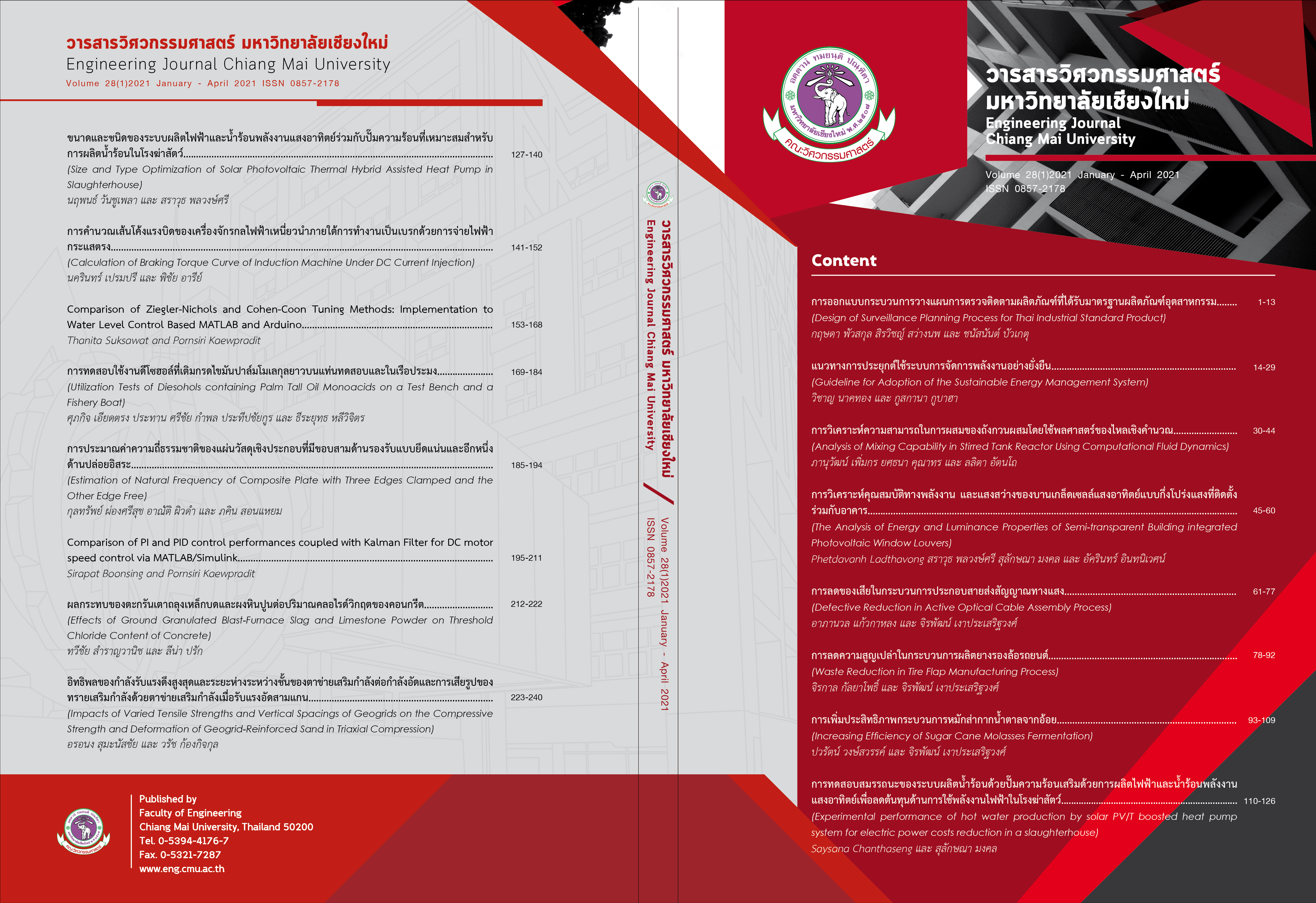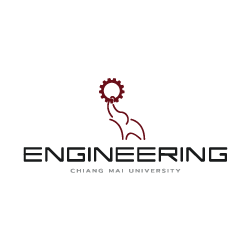Size and Type Optimization of Solar Photovoltaic Thermal Hybrid Assisted Heat Pump in Slaughterhouse
Keywords:
Solar PV/T, Heat pump, Performance, Hot water, SlaughterhouseAbstract
In Chiang Dao Municipality slaughterhouse, the electric heater was used to produce hot water of 2,500 liters at 65 ℃ for the scalding and scraping of pigs processes which wasted a lot of electricity. Therefore, this research aims to use solar photovoltaic thermal hybrid assisted heat pump to reduce electricity consumption. The mathematical model was developed for the optimum choosing of type and size of Solar PV/T both mono-Si PV/T and poly-Si PV/T based on economic analysis.
The study divided into two parts. The first part was a test to establish the mathematical equations to predict the performance of solar PV/T panels and heat pump performance. From the study, it was found that the mono-Si PV/T panels obtained FR(τα)e and FRUL with 0.328 and 7.2997 W/m2×K respectively, while FR(τα)e and FRUL of poly-Si PV/T panels were 0.275 and 8.4743 W/m2·K, respectively, and the average energy efficiency ratio (EER) of the heat pump was equal to
2.38 Wth/We. In the second part of the study, the mathematical models were used to predict the optimized system. It was found that the mono-Si PV/T of 295 WP 16 panels combined with the 17.8 kWth heat pump was the most suitable for producing hot water in Chiang Dao Municipality slaughterhouses. The electrical energy from the gridline could be decreased by 31,465.06 kWh/year or equivalent to a cost of electricity that compared to the electric heater use about 142,536.72 Baht/year. The system required an investment cost was 888,314.00 Baht and the payback period were equal to 6.23 years.
References
กรมพัฒนาพลังงานทดแทนและอนุรักษ์พลังงาน.แผนพัฒนาพลังงานทดแทนและพลังงานทางเลือกพ.ศ. 2558–2579. 2559.[ระบบออนไลน์] แหล่งที่มา:https://www.dede.go.th/download/files/AEDP2015_Final_version.pdf
กรมพัฒนาพลังงานทดแทนและอนุรักษ์พลังงาน. โครงการปรับปรุงแผนที่ศักยภาพพลังงานแสงอาทิตยจากภาพถ่ายดาวเทียมสําหรับประเทศไทย ปี 2560. 2560.[ระบบออนไลน์] แหล่งที่มา:https://www.dede.go.th/article_attach/developed_solarmap60%20-%20Copy.pdf
สวัสดิ์ ภูมิสวัสดิ์ และ วิจิตรา ภูมิสวัสดิ์. การศึกษาประสิทธิภาพของเครื่องทำน้ำร้อนพลงงานแสงอาทิตย์.วารสารวิศวกรรมศาสตร์ มหาวิทยาลัยศรีนครินทรวิโรฒ, 2562; 14(1): 67-77.
คอรีเยาะ,ดูมีแด ซูไรดา สือยุ และ ซุลกิพลี กาซอ.เครื่องทำน้ำร้อนพลังงานแสงอาทิตย์ร่วมไฟฟ้า.วารสารวิทยาศาสตร์และเทคโนโลยี มหาวิทยาลัยราชภัฏยะลา, 2560; 2(1): 65-75.
วิทยา ยงเจริญ และ ธวรรธน์ มาลาหอม. การเปรียบเทียบสมรรถนะของระบบทำน้ำร้อนที่ใช้แผงรับแสงอาทิตย์แบบแผ่นเรียบกับแบบท่อฮีตไปป์.วารสารวิจัยพลังงาน, 2554; 8(1): 64-72.
อาทิตย์ ไชยอรนันทน์,สมชาติ โสภณรณฤทธิ์ และ วารุณี เตีย. การทำน้ำร้อนด้วยปั๊มความร้อน.วิศวกรรมสาร ฉบับวิจัยและพัฒนา,2547;15(2): 31-37.
มารุต บูรพา,ณัฐนี วรยศ,ทนงเกยรตี เกียรติศิริโรจน์ และ สุริยนต์ ชมดี.โมเดลอย่างง่ายของการทำน้ำร้อนแสงอาทิตย์ ที่มีปั๊มความร้อนเสริม. วารสารคณะเทคโนโลยีอุตสาหกรรมมหาวิทยาลัยราชภัฏลําปาง, 2551; 1(2): 15-23.
สราวุธ พลวงษ์ศรี และ ทนงเกียรติ เกียรติศิริโรจน์. การเพิ่มสมรรถนะทางความร้อนของระบบทำน้ำร้อนแสงอาทิตย์ที่มีปั๊มความร้อนเสริมโดยการใช้สารละลายเงินนาโนในตัวรับรังสีอาทิตย์.วารสารวิชาการคณะเทคโนโลยีอุตสาหกรรม มหาวิทยาลัยราชภัฏลําปาง, 2556; 6(2): 106-120.
Sun, X., Dai, Y., Novakovic, V., Wu, J. and Wang, R. Performance Comparison of Direct Expansion Solar-Assisted Heat Pump and Conventional Air Source Heat Pump for Domestic Hot Water. Energy Procedia, 2015;70:394-401.
He, W., Chow, T.T., Ji, J., Lu, J., Pei, G. and Chan, L.S. Hybrid Photovoltaic and Thermal Solar-Collector Designed for Natural Circulation of Water. Applied Energy, 2006;83:199-210.
Aste, N., Del Pero, C. and Leonforte, F. Water PVT Collectors Performance Comparison. Energy Procedia, 2017;105: 961-966.
Yang, X., Sun, L., Yuan, Y., Zhao, X. and Cao, X. Experimental Investigation on Performance Comparison of PV/T-PCM System And PV/T System. Renewable Energy, 2018;119:152-159.
กรมพัฒนาพลังงานทดแทนและอนุรักษ์พลังงาน. ฐานข้อมูลความเข้มรังสีอาทิตย์ ระดับตำบล ปี 2560. 2560.[ระบบออนไลน์] แหล่งที่มา:https://www.dede.go.th/ewt_news.php?nid=47941&filename=solar_energy
Duffie, J.A. and Beckman, W.A. Solar Engineering of Thermal Processes. John Wiley & Sons, Inc., 2013.
ศูนย์อุตุนิยมวิทยาภาคเหนือ.สถิติภูมิอากาศเชียงใหม่. 2561. [ระบบออนไลน์] แหล่งที่มา:http://www.cmmet.tmd.go.th/
Chaichana, C., Kiatsiriroat, T. and Nuntaphan, A. Comparison of Conventional Flat-Plate Solar Collector and Solar Boosted Heat Pump Using Unglazed Collector for Hot Water Production in Small Slaughterhouse. Heat Transfer Engineering, 2010;31(5): 419-429.
Wanchupela, N. and Polvongsri, S. The Comparison Study of Performance between Two Different Types of Glazed Solar Photovoltaic Thermal Panels. The 1st International Conference on Informatics, Agriculture, Management, Business administration, Engineering, Science and Technology 2020,May 28-29, Diamond Plaza Hotel, Suratthani, Thailand, 2020.
Downloads
Published
Issue
Section
License
ลิขสิทธิ์ของบทความที่ตีพิมพ์ในวารสารฉบับนี้จะยังเป็นของผู้แต่งและยินยอมให้สิทธิ์เผยแพร่กับทางวารสาร
การเผยแพร่ในระบบวารสารแบบเปิดนี้ บทความจะสามารถนำไปใช้ได้ฟรีในการศึกษา และในทางที่ไม่เกี่ยวกับการค้า




